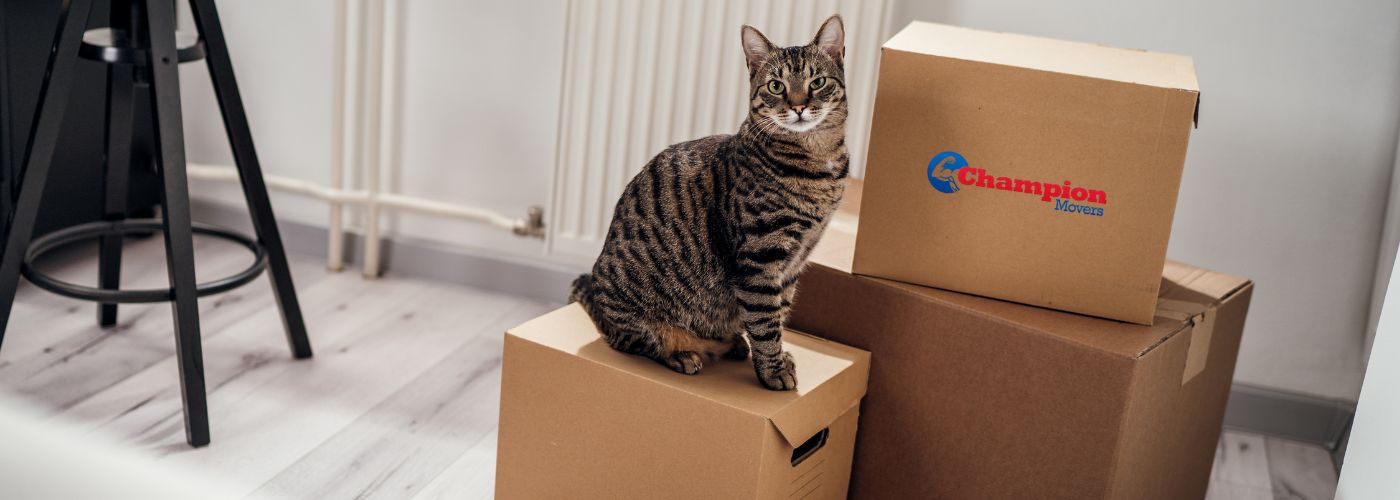Moving to a new home can be an exciting adventure, but it’s essential to consider the well-being of our furry family members throughout the process. Whether you’re moving locally or long-distance, ensuring a smooth transition as you get ready to move pets is a top priority.
In this post, we’ll explore valuable tips and insights on how to move pets without a hassle. From what to do with pets during the move to specific strategies for cats and addressing potential stress in dogs, let’s make the journey to a new home a comfortable one for our four-legged friends!
What To Do With Pets When Moving
The first step in ensuring a hassle-free move for your pets is thoughtful planning. Here’s a comprehensive guide on what to do with pets during the moving process:
Create a Safe Space: Designate a quiet and secure area where your pet can stay during the packing and moving activities. This could be a room with their bed, toys, and familiar items.
Update Identification: Ensure your pet’s identification tags are up-to-date with your new contact information. This can be especially important if planning for long-distance moving. If your pet is microchipped, verify that the information is current.
Visit the Vet: Schedule a visit to the veterinarian before the move. Ensure your pet is healthy for the journey and obtain any necessary medications or documents.
Maintain Routine: Stick to your pet’s regular feeding and walking schedule as much as possible. Consistency provides comfort during times of change.
Use Familiar Items: Pack your pet’s belongings, such as beds, blankets, and toys, in a separate box. Familiar scents can help ease anxiety.
Travel Arrangements: Plan your pet’s transportation method. If flying, check airline pet policies. If driving, secure a comfortable and safe space within the vehicle.
Check Pet-FriendlyAccommodations: If your moveinvolves an overnight stay, ensure your accommodations arepet-friendly. Research pet policies and inform them in advance.
 How To Make Moving Easier For Cats
How To Make Moving Easier For Cats
Cats are known for their sensitivity to environmental changes, making the moving process a potentially stressful experience. Here are specific strategies to make moving easier for your feline friends:
Gradual Introductions: Introduce moving boxes gradually to allow your cat to become accustomed to their presence. Cats may view unfamiliar items as potential threats, so giving them time to investigate can ease anxiety.
Familiar Scents: While tasks like packing dishes and essentials might be a priority, it can be helpful to set time aside for special packing plans for your pets. Place items with familiar scents in your cat’s carrier, such as a blanket or clothing. This provides comfort during the journey.
Quiet Transition: On a moving day, keep your cat in a quiet room with the door closed. This reduces exposure to noise and commotion, creating a stress-free environment.
Comfort Items in the Carrier: When transporting your cat, place familiar items in the carrier, along with a soft blanket or bedding. This helps create a cozy and secure space.
Set Up a Safe Space in the New Home: Upon arrival at your new home, set up a quiet room with your cat’s essentials. Allow them to explore the rest of the house at their own pace.
 Can Dogs Get Stressed From Moving?
Can Dogs Get Stressed From Moving?
Yes, dogs can experience stress during a move. Dogs are sensitive to changes in their surroundings and routines, and the upheaval of moving can trigger stress. Here’s how to recognize and address stress in dogs during a move:
Behavioral Changes: Watch for signs of stress, including changes in appetite, excessive barking, whining, or withdrawal. Dogs may exhibit different behaviors when stressed.
Familiar Items: Bring familiar items, such as your dog’s bed, toys, and bowls, to the new home. Having these familiar scents can provide a sense of comfort.
Regular Exercise: Don’t let checklist items like moving plants and valuables overwhelm your schedule. Maintain regular exercise and playtime to help release pent-up energy and reduce stress. Familiar walks in the new neighborhood can create positive associations.
Stay Calm and Positive: Dogs often pick up on their owner’s emotions. Stay calm and positive during the moving process, reassuring your dog with a soothing voice and gentle pats.
Routine Consistency: When planning to move pets, stick to your dog’s routine as closely as possible, including feeding times, walks, and play. Consistency provides a sense of security.
Ways To Deal With Pet Stress During Moving
Mitigating pet stress during a move is crucial for their well-being. Here are effective ways to deal with pet stress:
Pheromone Products: Consider using pheromone products, such as diffusers or sprays, designed to calm pets. These mimic natural calming signals and can be particularly helpful for cats and dogs.
Natural Calming Remedies: Explore natural calming remedies, such as herbal supplements or treats formulated to reduce pet anxiety. Consult with your veterinarian for recommendations.
Regular Breaks: If traveling a long distance, plan regular breaks to allow your pet to stretch their legs, have a bathroom break, and get some fresh air.
Comforting Reassurance: Offer comforting reassurance to your pet during the journey. Talk to them soothingly, pet them gently, and provide treats as positive reinforcement.
Moving with pets requires careful consideration and planning, but with the right approach, it can be a positive experience for you and your furry companions. By prioritizing their comfort, maintaining routines, and providing familiar items, you can ensure a hassle-free move that sets the foundation for a happy and stress-free life in your new home!



 How To Make Moving Easier For Cats
How To Make Moving Easier For Cats Can Dogs Get Stressed From Moving?
Can Dogs Get Stressed From Moving?